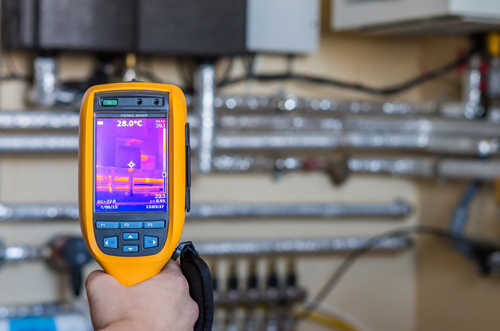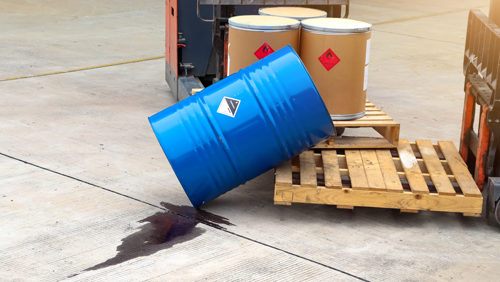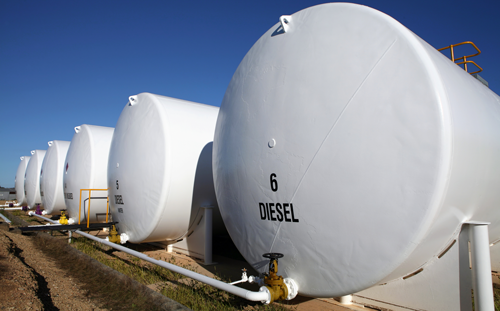Storing hazardous chemicals safely in the workplace
Workplace hazardous chemicals have the potential to cause significant harm to human health, the environment and property during use, storage and disposal.
There are many legal requirements in Work Health and Safety (WHS) and Occupational Health and Safety (OHS) legislation associated with hazardous chemicals, hazardous substances and dangerous goods. This article focuses on a selection of requirements for managing the health, safety and environmental risks of storing these chemicals in the workplace.
Using Safety Data Sheets to identify potential hazards
A Safety Data Sheet (SDS), prepared by the manufacturer or importer of a chemical, provides important information regarding the chemical’s identity, properties, classification, and guidance on emergency measures, disposal and transportation, among other things.
The Safety Data Sheet also contains information pertinent to storing chemicals, which is presented in Section 2 – Hazard Identification, Section 7 – Handling and Storage and Section 10 – Stability and Reactivity. These sections help persons understand the types of hazards associated with a chemical, how best to store it and factors which will affect the chemical’s stability and reactivity.
Safety Data Sheets must be included in the workplace’s chemical register for all hazardous chemicals onsite, and must always be easily accessible to those who use, handle, store or may be exposed to the chemical.

Health hazards and physical hazards from chemicals
The properties of a hazardous chemical determine its potential hazards, which are typically one of two types – health hazards (causing adverse health effects) and physical hazards (resulting in immediate injury to a person or damage to property). A chemical may be both a health and physical hazard. Understanding the health and physical hazards of a chemical can help you to then assess the risk of the hazard occurring.
The following sections detail some factors to consider in a hazardous chemical risk assessment, and examples of related control measures. Refer to your jurisdiction’s regulations and codes of practices for additional measures.
Incompatible chemicals
Storing incompatible chemicals together or storing a chemical in a container composed of incompatible material, can cause significant hazards such as explosion, release of toxic gases and chemical leaks.
Determining incompatible substances or materials for hazardous chemicals onsite can help with deciding how and where to store chemicals safely.
Measures to control the risk of incompatible chemicals
This may include, but not limited to:
- using the information in Section 10 – Stability and Reactivity in the Safety Data Sheet to understand the incompatibility of chemicals.
- using techniques such as barriers, separate rooms, or external storage tanks to separate incompatible substances and materials. The Safe Work Australia Publication: Managing Risks of Storing Chemicals in the Workplace provides a Segregation Chart based on the dangerous goods class and GHS hazard class of a chemical. For example, flammable gases and flammable aerosols (class 2.1 dangerous goods) should be stored at least 5 metres away from pyrophoric solids, liquids and gases and self-heating substances and mixtures (class 4.2 dangerous goods).
- not storing liquid chemicals above solid chemicals.
- not allowing incompatible chemicals to share secondary containment structures or drainage systems.
Reactivity and stability
Similarly to incompatibility, the stability and reactivity of a hazardous chemical may present significant hazards. A chemical may by its nature be highly reactive, prone to instability in certain conditions, or react with other chemicals.
It is important to understand the conditions to be avoided, and the stability and reactivity, of chemicals to reduce the potential for uncontrolled or violent reactions.
Measures to limit chemical reactions
This may include the following:
- using the information in Section 10 – Stability and Reactivity in the Safety Data Sheet to understand the reactivity of chemicals.
- considering the layout of the workplace, including location of utility services, pipework and nearby work areas.
- controlling the temperature of the surrounding environment as appropriate.
- ensuring the storage system implemented is only used for the purpose for which it was designed.
- ensuring any storage systems and areas for bulk chemicals are fixed on stable foundations and protected from impact or damage.
- ensuring safety signs are displayed next to hazardous chemicals to warn workers, contractors or visitors of the hazards. Placards may be required for some chemicals.
- storing hazardous chemicals in restricted access areas and away from foot or vehicle traffic.
- ensuring a competent person provides information, training and instruction to those involved in the use, storage, and handling of hazardous chemicals and those likely to be exposed to it, including visitors.

Ignition sources
An ignition source is an energy source that could ignite a fuel, for example gas heaters, direct sunlight or sources generated by not-so-obvious means. Flammable chemicals (solids, liquids or gases) or other fire-risk substances may, when combined with oxygen and an ignition source, create the perfect conditions for a fire or explosion.
Measures to control the risk of ignition sources
This may include, but not limited to:
- keeping storage areas clean and free from combustible materials such as paper or wood.
- installing systems to detect leaks of flammable gases or vapours.
- conducting activities such as hot work in areas where there are no flammable or combustible chemicals present.
- storing hazardous chemicals out of direct sunlight or excessive heat.
- implementing appropriate fire protection for the types and quantities of hazardous chemicals present.

Spills, leaks, or accidental releases
Stored chemicals may spill, leak or be accidentally released for several reasons, including but not limited to:
- Incompatible storage – For example, substances corrosive to metals stored in inappropriate containers, resulting in corrosion of the container and leakage.
- Damaged or faulty storage – For example, damaged or degraded cylinder fittings or hoses, resulting in gas leakage.
- Inadequate storage – For example, uncontained and uncovered bulk solid materials exposed to rain, resulting in releases to land and water.
- Inappropriate storage location – For example, large containers stored outside without a secondary containment system.
- Human error – For example, damaged or uncapped containers, resulting in the release of toxic vapours indoors and creation of a hazardous atmosphere.
Measures to control the risk of spills, leaks and accidental releases
This may include but not limited to:
- having the most appropriate spill response equipment to clean up and dispose of any spilled or leaked chemical in accordance with regulations, such as spill kits.
- implementing suitable primary containment (i.e. drums, intermediate bulk containers (IBC) or bulka bags) and secondary containment infrastructure (i.e. bunding or encasement) for the types and quantities of chemicals stored.
- using interceptor systems or mesh drain guards to prevent materials or liquids escaping into drains.
- implementing the most appropriate ventilation system for the hazardous chemicals stored onsite.
- baling, bundling, bagging or covering solid materials that might be blown or washed away.
- implementing incident management plans to manage chemical spills and leaks effectively and efficiently and without causing harm to workers, the environment or property.

Using the hierarchy of control to minimise risks
There is a general requirement in OHS and WHS regulations to work through the hierarchy of control to effectively manage the health and safety risks associated with storing hazardous chemicals.
Elimination of the hazard is ideal, however if that is not practicable, then the following levels of control in the hierarchy must be considered. Here are some examples for each level in the hierarchy:
- Elimination – Removing the need to use a hazardous chemical.
- Substitution – Replacing a hazardous chemical with a less hazardous one. For example, replacing flammable solvent-based inks with non-flammable water-based inks.
- Isolation – Keeping a hazardous chemical away from people. For example, separating incompatible chemicals and storing hazardous chemicals away from people and work areas.
- Engineering controls – Using physical controls. For example, using local exhaust ventilation to remove airborne contaminants before a worker breathes them in.
- Administrative controls – Using systems of work and work procedures. For example, restricting access to a hazardous chemical, having clear signage and marking, and providing information, instruction and training.
- Personal Protective Equipment (PPE) – Providing and using appropriate PPE. For example, providing gloves that are resistant to the chemical to be used or handled.

Monitoring risk control measures for hazardous chemical storage
It is important to regularly assess whether the risk control measures implemented for hazardous chemicals continue to be suitable and sufficient. The following actions may assist with this monitoring, and help ensure the hazardous chemicals continue to be stored safely in the workplace:
- Conducting regular inspections on chemical containers, cylinders, valves, or secondary containment infrastructure, among other things, to ensure there are no leaks or signs of damage, degradation, or corrosion.
- Conducting regular preventative maintenance checks on chemical handling systems to ensure their integrity and replacing or repairing any faulty systems as soon as practicable.
- Conducting regular air monitoring to ensure that the airborne concentration of a substance does not exceed the relevant workplace exposure standard.
- Decommissioning any old hazardous chemical storage or handling systems.
- Notifying the relevant regulatory authority of any abandoned underground tanks that previously stored flammable liquids or flammable gases.
- Disposing of any hazardous chemicals that have passed their expiry date in accordance with the manufacturer’s instructions and the jurisdiction’s regulations.
- Maintaining the information in the chemical register, including the Safety Data Sheets.
References
- EPA Victoria Publication: Liquid Storage and Handling Guidelines
- EPA Victoria Publication: Solid Storage and Handling Guidelines
- Globally Harmonised System of Classification and Labelling of Chemicals (GHS) 7th Edition
- Model Work Health and Safety Regulations
- Safe Work Australia Publication: Fact Sheet – Understanding Safety Data Sheets for Hazardous Chemicals
- Safe Work Australia Publication: Managing Risks of Storing Chemicals in the Workplace
- Safe Work Australia Publication: Model Code of Practice – Managing Risks of Hazardous Chemicals in the Workplace
- Safe Work Australia Publication: Work Health and Safety Regulations: Classification and Labelling for Workplace Hazardous Chemicals
- Safe Work Australia Publication: Workplace Exposure Standards for Airborne Contaminants (2022)
- Safe Work Australia Webpage: Hazardous Chemicals Register
- Safe Work Australia Webpage: Hazardous Chemicals Signs (Placards)
- Safe Work Australia Webpage: Preparing Safety Data Sheets
- Safe Work Australia Webpage: Storing Hazardous Chemicals
- Safe Work Australia Webpage: Using Safety Data Sheets
- Safe Work Australia Webpage: WHS Duties Related to Hazardous Chemicals
- Victorian Legislation: Dangerous Goods (Storage and Handling) Regulations 2022
- Victorian Legislation: Occupational Health and Safety Regulations 2017
